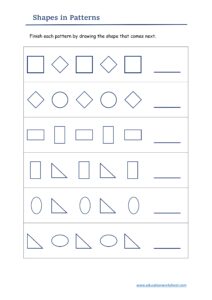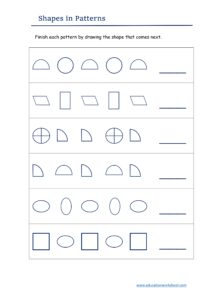Geometric shape patterns
Geometric shape patterns
Geometric shape patterns are visually striking and versatile designs created by arranging basic geometric shapes, such as circles, squares, triangles, and rectangles, in repetitive and often symmetrical arrangements. These patterns are used in various artistic and design contexts, from textiles and wallpapers to digital art and architecture. Here, we’ll explore different types of geometric shape patterns and how to create them:
1. Basic Geometric Patterns:
- Checkerboard Pattern: This classic pattern alternates between squares of two contrasting colors. It’s simple yet bold and works well in various design applications.
- Stripes: Stripes are a straightforward geometric pattern, often featuring parallel lines of equal width. They can be horizontal, vertical, or diagonal and can create a sense of movement and rhythm.
2. Tessellations:
- Regular Tessellations: In these patterns, geometric shapes fit together perfectly, covering a surface without overlapping or leaving gaps. Examples include hexagonal tessellations, which you might see in honeycomb patterns.
- Penrose Tiles: These are a unique form of non-periodic tessellations, where specific geometric shapes are combined to create patterns that never repeat exactly. They have interesting optical properties.
3. Islamic Geometric Patterns:
- Arabesque Patterns: Often found in Islamic architecture and art, these patterns consist of intricate interlocking shapes and often feature stars, polygons, and calligraphy.
4. Fractal Patterns:
- Mandelbrot Set: A famous example of a fractal pattern, it’s created by iterating a simple mathematical equation. Zooming in reveals ever more complex and self-replicating shapes.
5. Escher-like Patterns:
- Impossible Figures: These patterns, inspired by the artwork of M.C. Escher, play with optical illusions and the perception of three-dimensionality in two-dimensional art.
-

Geometric shape patterns
How to Create Geometric Shape Patterns:
- Choose Your Shapes: Decide which geometric shapes you want to use in your pattern. You can use a single shape or combine several for added complexity.
- Plan the Layout: Determine the layout or arrangement of your shapes. Consider whether you want a regular grid, a radial design, or something more freeform.
- Select Colors: Choose a color scheme that complements your design. You can go for bold, contrasting colors or opt for a more subdued, monochromatic palette.
- Sketch or Digitize: Begin by sketching your pattern lightly on paper if working traditionally. If working digitally, create a canvas or use graphic design software to draw your pattern.
- Repeat and Adjust: Start arranging your chosen shapes within your layout. Ensure that the pattern repeats consistently and that the shapes fit together seamlessly.
- Experiment: Don’t be afraid to experiment with scale, rotation, and orientation of your shapes to create visual interest.
- Detail and Refine: Add details, such as lines, textures, or shading, to enhance the pattern’s depth and complexity.
- Review and Finalize: Step back periodically to review your work and make any necessary adjustments. Once you’re satisfied, finalize your pattern.
- Save and Share: Save your pattern in a suitable digital format (e.g., JPEG, PNG) for your intended use. You can also share your design with others or apply it to various projects.
Creating geometric shape patterns allows for endless creativity and can be a rewarding artistic endeavor. Whether you’re designing patterns for textiles, decor, or digital art, experimenting with shapes and arrangements can result in visually captivating and unique designs.

Here are some common types of geometric shape patterns and examples:
- Tessellations:
- Description: Tessellations are patterns formed by repeating one or more shapes, such as triangles, squares, or hexagons, without any gaps or overlaps.
- Example: Escher’s famous artwork often features tessellations, where he used interlocking lizards, birds, and fish to create intricate patterns.
- Chevron Patterns:
- Description: Chevron patterns consist of repeated V or zigzag shapes, creating a bold and dynamic look.
- Example: Chevron patterns are commonly seen in fashion, home decor, and graphic design. They can be horizontal, vertical, or diagonal.
- Herringbone Patterns:
- Description: Herringbone patterns are formed by arranging rectangular shapes, like parallelograms or rectangles, at 45-degree angles to create a zigzag effect.
- Example: Herringbone patterns are often used in flooring, textiles, and brickwork.
- Mosaic Patterns:
- Description: Mosaic patterns involve using small geometric shapes, often squares or triangles, to create larger compositions.
- Example: Ancient Roman and Byzantine art frequently featured mosaic patterns in architecture and artwork.

